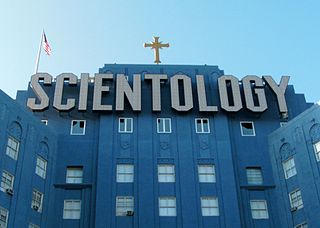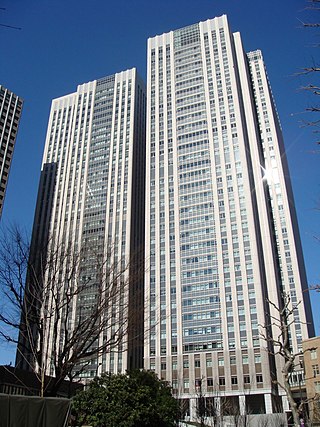
A board of directors is an executive committee that jointly supervises the activities of an organization, which can be either a for-profit or a nonprofit organization such as a business, nonprofit organization, or a government agency.
Corporate titles or business titles are given to corporate officers to show what duties and responsibilities they have in the organization. Such titles are used by publicly and privately held for-profit corporations, cooperatives, non-profit organizations, educational institutions, partnerships, and sole proprietorships that also confer corporate titles.
Business is the practice of making one's living or making money by producing or buying and selling products. It is also "any activity or enterprise entered into for profit."
A chief executive officer (CEO) is the highest officer charged with the management of an organization – especially a company or nonprofit institution.

A dōjō is a hall or place for immersive learning, experiential learning or meditation. This is traditionally in the field of martial arts, but has been seen increasingly in other fields, such as meditation and software development. The term literally means "place of the Way" in Japanese.

The U.S. Military Assistance Command, Vietnam (MACV) was a joint-service command of the United States Department of Defense, composed of forces from the United States Army, United States Navy, and United States Air Force, as well as their respective special operations forces.
An executive officer is a person who is principally responsible for leading all or part of an organization, although the exact nature of the role varies depending on the organization. In many militaries and police forces, an executive officer, or "XO", is the second-in-command, reporting to the commanding officer. The XO is typically responsible for the management of day-to-day activities, freeing the commander to concentrate on strategy and planning the unit's next move.

Military districts are formations of a state's armed forces which are responsible for a certain area of territory. They are often more responsible for administrative than operational matters, and in countries with conscript forces, often handle parts of the conscription cycle.

A military staff or general staff is a group of officers, enlisted and civilian staff who serve the commander of a division or other large military unit in their command and control role through planning, analysis, and information gathering, as well as by relaying, coordinating, and supervising the execution of their plans and orders, especially in case of multiple simultaneous and rapidly changing complex operations. They are organised into functional groups such as administration, logistics, operations, intelligence, training, etc. They provide multi-directional flow of information between a commanding officer, subordinate military units and other stakeholders. A centralised general staff results in tighter top-down control but requires larger staff at headquarters (HQ) and reduces accuracy of orientation of field operations, whereas a decentralised general staff results in enhanced situational focus, personal initiative, speed of localised action, OODA loop, and improved accuracy of orientation.
In Japan, the Imperial Guard is the name for two separate organizations dedicated to the protection of the Emperor of Japan and the Imperial Family, palaces and other imperial properties. The first was the Imperial guard divisions, a quasi-independent elite branch of the Imperial Japanese Army which was dissolved shortly after World War II. The second is the Imperial Guard Headquarters, a civilian law enforcement organization formed as part of the National Police Agency. (警察庁)

The Directorate of Operations (DO), less formally called the Clandestine Service, is a component of the US Central Intelligence Agency. It was known as the Directorate of Plans from 1951 to 1973; as the Directorate of Operations from 1973 to 2005; and as the National Clandestine Service (NCS) from 2005 to 2015.

The United States Army, Vietnam (USARV) was a Corps-level support command of the United States Army during the Vietnam War.
The following outline is provided as an overview of and topical guide to business management:
The structure of the United States Air Force refers to the unit designators and organizational hierarchy of the United States Air Force, which starts at the most senior commands.
Internal control, as defined by accounting and auditing, is a process for assuring of an organization's objectives in operational effectiveness and efficiency, reliable financial reporting, and compliance with laws, regulations and policies. A broad concept, internal control involves everything that controls risks to an organization.

Corporate headquarters is the part of a corporate structure that deals with tasks such as strategic planning, corporate communications, taxes, law, books of record, marketing, finance, human resources, and information technology. Corporate headquarters takes responsibility for the overall success of the corporation and ensures corporate governance. It is sometimes referred to as the head office, which is the location where the executives of a business work and where many of the key business decisions are made. Generally, corporate headquarters acts as a core when the business is operating.
Chief business officer (CBO) is the position of the top operating executive of growing commercial companies or an academic/research institution. In the commercial space, CBO shows leadership in deal-making experience with a clear record of results and ultimate transactional responsibility. In higher education, the titles of vice president, associate dean, assistant dean, and director are also used for the role of the chief business officer.
Land Command was a military command and formation and part of the structure of the British Army from 1995 to 2008. Its headquarters was at Erskine Barracks, at Fugglestone St Peter, some four kilometres northwest of Salisbury in Wiltshire.

The Church of Scientology International (CSI) is a California 501(c)(3) non-profit corporation. Within the worldwide network of Scientology corporations and entities, CSI is officially referred to as the "mother church" of the Church of Scientology.

The Headquarters for Earthquake Research Promotion is an extraordinary organ of the Japanese Ministry of Education, Culture, Sports, Science and Technology. It was established in 1995, as a response to the damage caused by the Great Hanshin earthquake, to promote research on earthquakes in order to minimize their potential for destruction.














